Proper number, placement of paddlewheels varies on pond shape, production levels
 Appropriate site selection, design and management are fundamental factors that contribute to the success or failure of a shrimp farm. One of the key aspects of intensive shrimp farm management is proper pond aeration.
Appropriate site selection, design and management are fundamental factors that contribute to the success or failure of a shrimp farm. One of the key aspects of intensive shrimp farm management is proper pond aeration.
Pond aeration is the primary life-support system of an aquaculture pond. The splash from a paddlewheel and the bubble-jet from an aspirator both enhance the exchange of dissolved gases between air and water. This allows oxygen to enter the pond, while carbon dioxide and ammonia escape.
Aerators enhance gas transfer by distorting and stretching the air-water interface, and by creating intense turbulence that rolls the water column, so more gas molecules are pumped across the interface. Our hearts and lungs provide a similar action, so that each cell in our bodies can be constantly refreshed with air.
Aerators serve as the heart and lungs of an aquaculture pond. Ideally, they should create a uniform movement of water to keep organics in suspension and exposed to dissolved oxygen. But there are no veins or arteries to distribute and control the flow within a pond, and there may be places where flow is excessive and harmful (Boyd 1995).
Shear stress
The quality of the circulation in a pond can be evaluated in terms of the shear stress drag of the bottom (Peterson 1999). Shear stress of more than 0.03 N per square meter will scour silt from banks and smother feed areas so they become anaerobic. This intense stress is the result of surface currents above 12 centimeters per second, which can be observed by using a stopwatch and tracking flotsam passing by a feed-tray station.
Need for aeration
Ponds need to be mechanically aerated when production biomass exceeds 2 tons per hectare, and added at a rate of two kW for each additional ton (Boyd 1998). The moderate circulation effect provided by one or two aerators is desired from the time of stocking. Without circulation a pond would become stagnant, especially in the dog-days of summer. Ideally, surface circulation should be about 4 cm per second during feeding, so that fresh pellets are not disturbed, but finer organics are kept in suspension (Peterson 1999).
Managing circulation problems
The number of aerators must be increased as crop biomass grows above 2 tons per hectare, when problems with excessive circulation begin. These problems can be managed by lining pond banks with plastic or stone, controlling the speed of aerators, and by arranging the aerators so stress is more uniformly distributed.
A small, central dead spot should be provided, where suspended matter can settle out of suspension. The central area of a pond acts as an internal sediment trap, essential for cleansing detritus and eroded clay minerals.
Round peg in a square hole
The biggest problem with controlling circulation in ponds is that they are usually built in a rectangular shape. The problem is worse where corners are very tight and oblique. The water is doing its best to circulate around the pond and then it runs into a wall and needs to suddenly change direction, creating dead spots in the prime feed zone.
Pond shapes should be evaluated by how closely they approach the perfect circle. The best type of rectangle is an even square with rounded corners. Elongated raceways with a central baffle (“Burroughs Raceway”) also have a proven record in aquaculture and waste treatment, but they were not tested in this study.
Appropriate aerator positioning
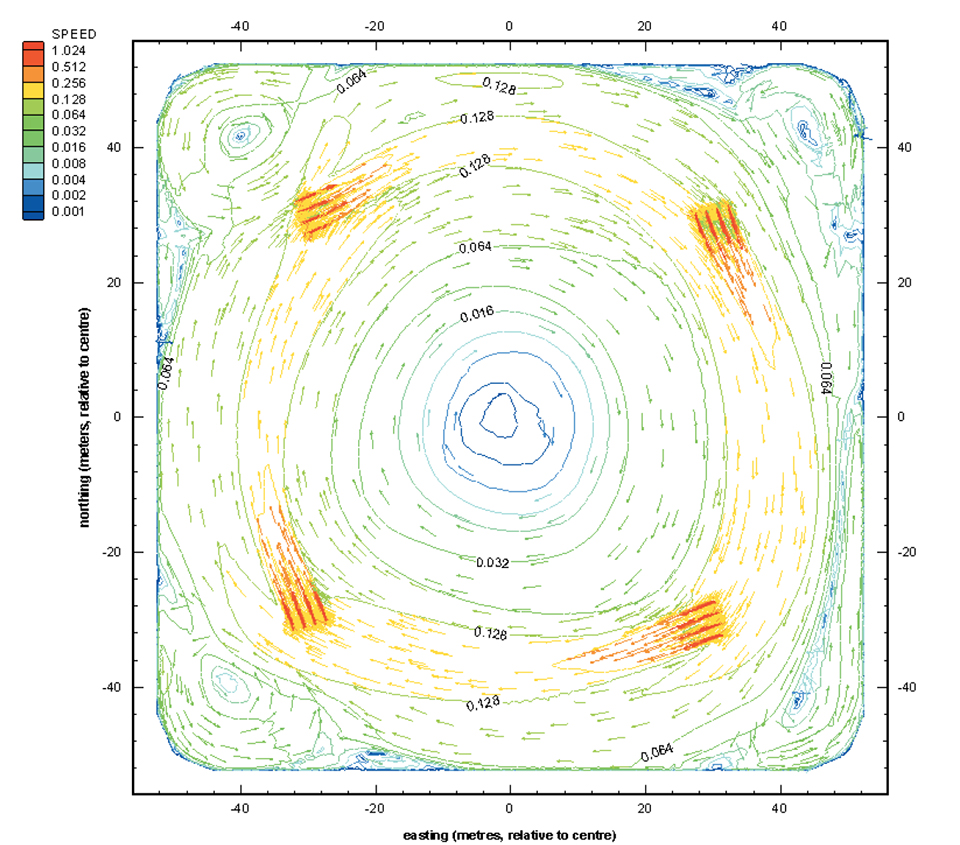
Here we show an arrangement of aerators that is most appropriate for square ponds with one paddlewheel in each corner. Doug Pearson saw this arrangement in Thailand and tried it with great success at Noel Herbst’s farm on the Gold Coast. Also, the senior author simulated this arrangement at James Cook University. The simulations presented here were limited to four paddlewheels by the level of computer technology available.
Near optimum arrangement
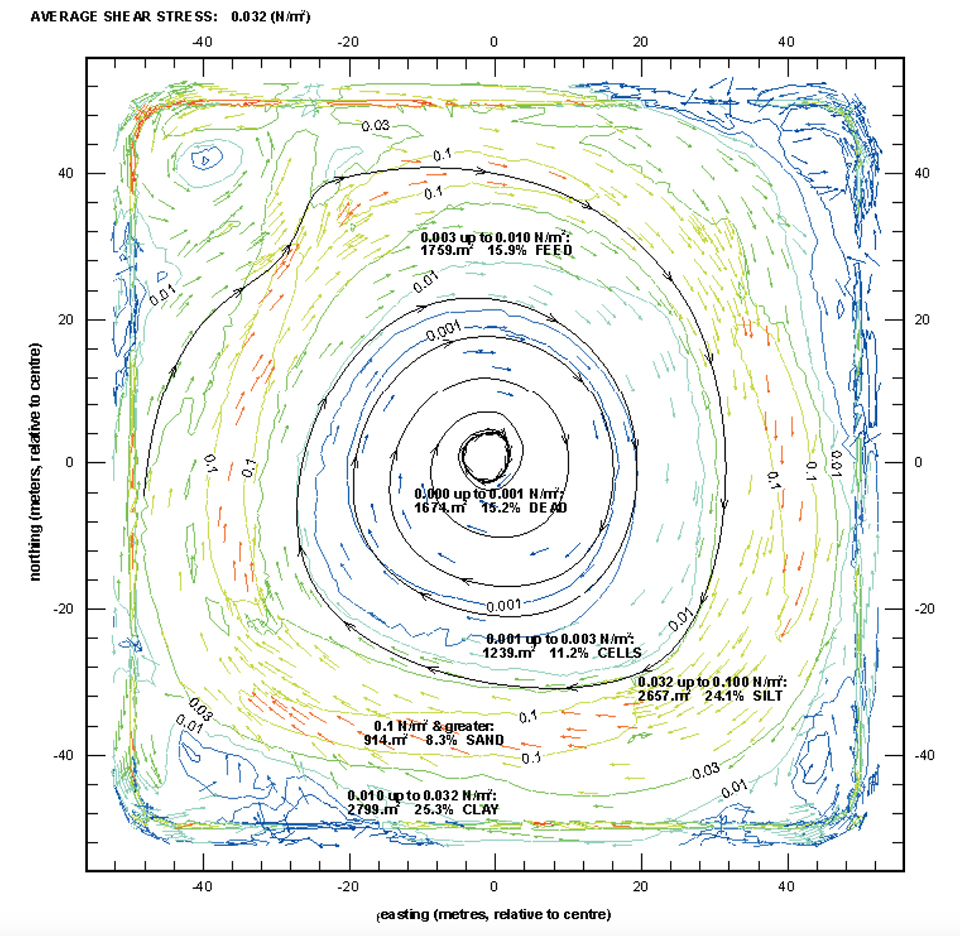
Fig. 1 illustrates a pond with four 2-hp paddlewheels arranged in a square, 1-ha pond to provide a gentle sweeping of the feed area and support a product biomass of five tons. Grow-out to a higher biomass requires the provision of aspirator aerators deployed further out in the pond. Although aspirator aerators can scour the pond bottom, that can be fixed by placing a patch of gravel or other hard material on the offending spot.
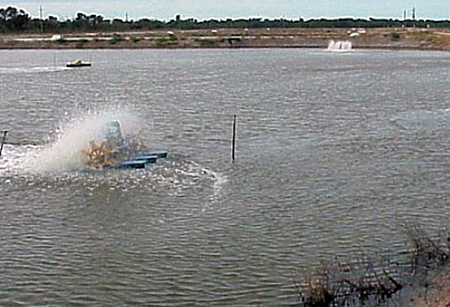
The arrangement of aerators in Fig. 1 is near optimum. Each paddlewheel is aimed into the next corner to prevent the formation of dead spots. The arrangement promotes the divergence of water at the surface, and convergence inward at the bottom. The cyclonic circulation creates a low-pressure region at the center of the pond that tends to vacuum uneaten feed and detritus into a concentrated pile of sludge.
Expected bottom stress
Fig. 2 illustrates the distribution of bottom stress expected to result from the preferred arrangement. Note how the particle track of feed pellets spirals into the center. Also note the desirable “green zone” of cells, feed, and clay that covers 52 percent of the pond bottom area, while the red and yellow regions of sand and silt scouring occupies only 32 percent.
The trick with this arrangement is that the paddlewheels are placed 20 meters offshore with direct surface currents set into the pond corners. It is not expected that propeller-aspirators would perform this function, but they are convenient and recommended to use later in the crop when the production biomass exceeds five tons. Aspirators should be arranged to extend the clean-swept zone within that created by the four paddlewheels, but not obliterate the central sediment trap.
Pond sediment quality
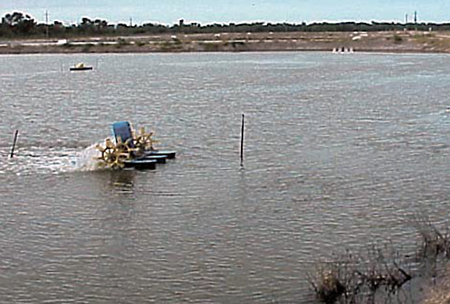
Daylight speed control of pond aeration systems improves sediment conditions and dramatically reduces power costs (Figs. 3 and 4). Two square ponds are currently stocked with the marine shrimp Metapeneus merguensis and aerated with four paddlewheels and four propeller-aspirators. Pond A is aerated continuously day and night at full speed with an electric demand of 13 kW. A photoelectric switch triggers automatic reduction of speed of the aerators in Pond B from sunrise until sunset.
Feed pellets placed in pond B are not swept away from feed trays until nightfall, when photosynthesis ends and aeration is required. Power consumption of pond B was automatically reduced 80 percent during daylight hours. As a result, the sediments in ponds A and B had very different redox profiles as diagrammed in the cross-section of Fig. 5. Positive redox is associated with beneficial nitrifying bacteria (Muir and Owens 1997).
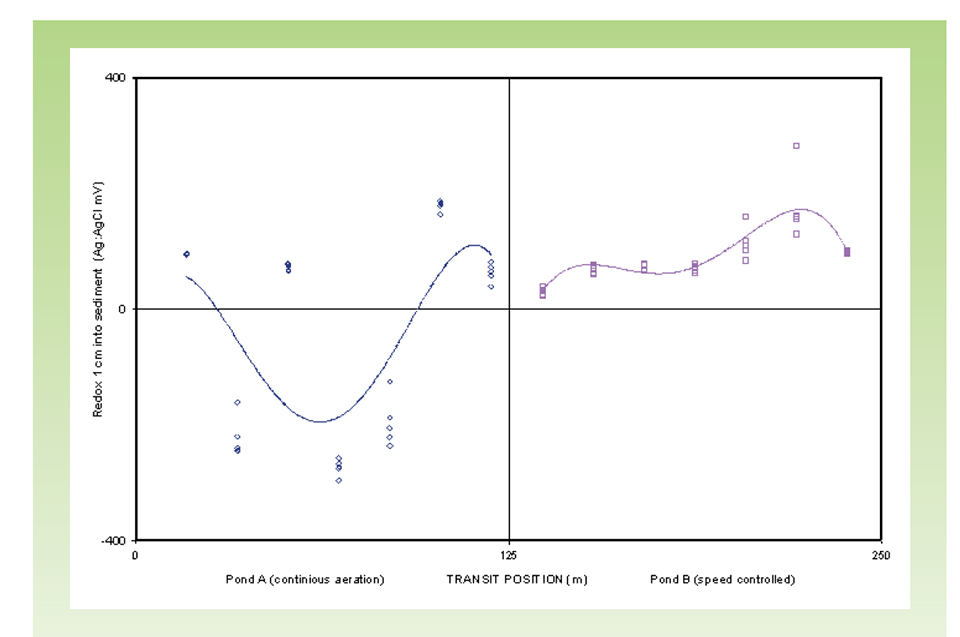
Conclusion
Prawn farming can be sustainable and profitable if attention is paid to the successes and failures of previous ventures. Although this article discusses aeration strategies that have proved successful in square ponds, farmers should always carefully evaluate their unique situations before taking up new technology. It is most important to follow a strict and consistent program of monitoring pond water, sediment quality and productivity.
Note: List of cited references available upon request to senior author.
(Editor’s Note: This article was originally published in the October 2000 print edition of the Global Aquaculture Advocate.)
Now that you've finished reading the article ...
… we hope you’ll consider supporting our mission to document the evolution of the global aquaculture industry and share our vast network of contributors’ expansive knowledge every week.
By becoming a Global Seafood Alliance member, you’re ensuring that all of the pre-competitive work we do through member benefits, resources and events can continue. Individual membership costs just $50 a year. GSA individual and corporate members receive complimentary access to a series of GOAL virtual events beginning in April. Join now.
Not a GSA member? Join us.
Authors
-
Eric Peterson, Ph.D., RPEQ
Aquaculture CRC and School of Engineering
James Cook University
Townsville 4811 Australia -
Tagged With
Related Posts

Responsibility
Aeration, mixing and sludge control in shrimp ponds
A benefit of aeration is the mixing of pond water. Similar to biotechnological reactors, microbial processes are more effective in mixed pond water.

Responsibility
Appraising pond liners for shrimp culture
The use of plastic-lined ponds by shrimp farmers can significantly improve production efficiency, support more production cycles per year, and higher mechanical aeration rates and stocking densities. The capital cost of lining ponds can be very significant, so a thorough feasibility analysis is recommended when considering this production tool.

Responsibility
Energy use in aquaculture pond aeration, Part 1
Prof. Boyd discusses energy use in aeration for aquaculture production systems, along with rates, types of aerators, motors and electricity generation.

Responsibility
Measuring circulation, mixing in ponds
There are several methods for evaluating water circulation and mixing in aquaculture ponds. Measurements of concentrated salt dispersal can be complex.


